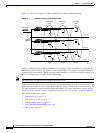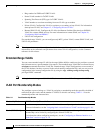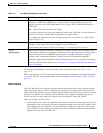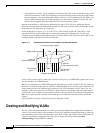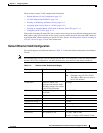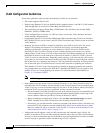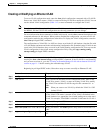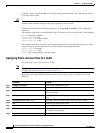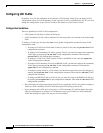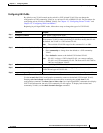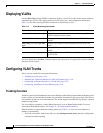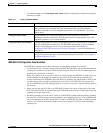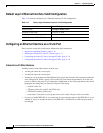
11-9
Cisco ME 3400 Ethernet Access Switch Software Configuration Guide
78-17058-01
Chapter 11 Configuring VLANs
Creating and Modifying VLANs
Creating or Modifying an Ethernet VLAN
To access VLAN configuration mode, enter the vlan global configuration command with a VLAN ID.
Enter a new VLAN ID to create a VLAN, or enter an existing VLAN ID to modify that VLAN. You can
use the default VLAN configuration (Table 11-2) or enter commands to configure the VLAN.
Note Extended-range VLANs use the default Ethernet VLAN characteristics and the MTU, the private VLAN,
the RSPAN, and the UNI-VLAN configurations are the only parameters you can change.
For more information about commands available in this mode, see the vlan command description in the
command reference for this release. When you have finished the configuration, you must exit VLAN
configuration mode for the configuration to take effect. To display the VLAN configuration, enter the
show vlan privileged EXEC command.
The configurations of VLAN IDs 1 to 1005 are always saved in the VLAN database (vlan.dat file) with
a VLAN number and name and in the switch running configuration file. Extended-range VLANs are not
saved in the VLAN database; they are saved in the switch running configuration file. You can save the
VLAN configuration in the switch startup configuration file by using the copy running-config
startup-config privileged EXEC command.
Note Before you create an extended-range VLAN, you can verify that the VLAN ID is not used internally by
entering the show vlan internal usage privileged EXEC command. If the VLAN ID is used internally
and you want to release it, go to the “Creating an Extended-Range VLAN with an Internal VLAN ID”
section on page 11-11 before creating the extended-range VLAN.
Beginning in privileged EXEC mode, follow these steps to create or modify an Ethernet VLAN:
Command Purpose
Step 1
configure terminal Enter global configuration mode.
Step 2
vlan vlan-id Enter a VLAN ID, and enter VLAN configuration mode. Enter a new
VLAN ID to create a VLAN, or enter an existing VLAN ID to modify
that VLAN. The available VLAN ID range for this command is 1 to
4094.
Note When you create a new VLAN, by default the VLAN is a UNI
isolated VLAN.
Step 3
name vlan-name (Optional and supported on normal-range VLANs only) Enter a name
for the VLAN. If no name is entered for the VLAN, the default in the
VLAN database is to append the vlan-id with leading zeros to the word
VLAN. For example, VLAN0004 is a default VLAN name for VLAN 4.
Step 4
mtu mtu-size (Optional) Change the MTU size.
Step 5
end Return to privileged EXEC mode.
Step 6
show vlan {name vlan-name | id vlan-id} Verify your entries. The name option is only valid for VLAN IDs 1 to
1005.
Step 7
copy running-config startup config (Optional) Save the configuration in the switch startup configuration
file.




